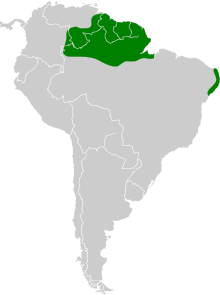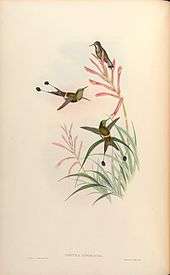Racket-tailed coquette
| Racket-tailed coquette | |
|---|---|
| | |
| Mounted specimen of Discosura longicaudus, the racket-tailed coquette. | |
| Scientific classification | |
| Kingdom: | Animalia |
| Phylum: | Chordata |
| Class: | Aves |
| Order: | Apodiformes |
| Family: | Trochilidae |
| Genus: | Discosura |
| Species: | D. longicaudus |
| Binomial name | |
| Discosura longicaudus Gmelin, 1788 | |
 | |
| Range of the racket-tailed coquette | |
| Synonyms[2] | |
|
Discosura longicauda (Gmelin, 1788) | |
The racket-tailed coquette (Discosura longicaudus; sometimes Discosura longicauda[3]) is a species of hummingbird in the family Trochilidae native to northern South America.
Taxonomy

German naturalist Johann Friedrich Gmelin described the racket-tailed coquette in 1788.[4] Its species name is from the Latin words longus "long" and cauda "tail".[5] It is sometimes considered to be the only member of the genus Discosura, as the thorntails, the other possible members of the genus, are often placed in the genus Popelairia.[6][7]
Martin Johnson Heade depicted two coquettes in his painting Two Green-Breasted Hummingbirds (c. 1863), as part of his "Gems of Brazil".[8]
Description
The species weighs about 3.4 grams (0.12 oz) and is sexually dimorphic. The male is around 10.2 centimetres (4.0 in) long and has a distinctive brilliant green head and throat with a copper-coloured abdomen. The dark purple-brown tail is 5.1 centimetres (2.0 in) long, and forked, with two very long prongs, ending with a pair of round paddle- ("racket") shaped feathers. The female is shorter with a length of 6.9 centimetres (2.7 in). It has duller green upperparts and breast, black throat bordered by white and a white belly. Its tail is grey tipped with white,[9] and lacks "rackets".[10]
Distribution and habitat
The racket-tailed coquette has a wide distribution range; it is found in northern Brazil, French Guiana, Guyana, Suriname, and southern Venezuela. It is also found on the eastern tip of Brazil[6] Its natural habitat is subtropical or tropical moist lowland forests, as well as riparian forests and scrubby savannahs.[7]
Behavior
Racket-tailed coquettes typically gather in the canopy of hapaxanth trees with other hummingbirds and steal other larger hummingbirds' nectar. They are consequently chased by the larger birds.[9]
They build their cup-sized nests out of soft plants and down 3–6 metres (9.8–19.7 ft) up a tree. Females usually have a clutch of two eggs, which are incubated for 13–14 days.[10]
References
- ↑ BirdLife International (2012). "Discosura longicaudus". IUCN Red List of Threatened Species. Version 2013.2. International Union for Conservation of Nature. Retrieved 26 November 2013.
- ↑ "Discosura longicaudus (Gmelin, 1788)". Colaboraciones Americanas Sobre Aves. Retrieved 23 February 2013.
- ↑ "Zoological Citation Notes --L". Zoological Nomenclature Resource. 14 July 2002. Retrieved 23 February 2013.
- ↑ Sibley, Charles Gald; Monroe, Burt Leavelle (1990). Distribution and Taxonomy of Birds of the World. Yale University Press. p. 148. ISBN 0300049692.
- ↑ Jobling, James A. (2010). Helm Dictionary of Scientific Bird Names (PDF). Christopher Helm. p. 229. ISBN 978-1-4081-2501-4. Retrieved 23 February 2013.
- 1 2 "Racket-tailed Coquette (Discosura longicauda)". The Internet Bird Collection. Retrieved 21 February 2013.
- 1 2 Sedgwick, Carolyn W. (2011). T. S. Schulenberg, ed. "Discosura longicaudus". Neotropical Birds. Cornell Lab of Ornithology. Retrieved 26 February 2013.
- ↑ Theodore E. Jr., Stebbins; Comey, Janet L.; Quinn, Karen E. (2000). The Life and Work of Martin Johnson Heade: A Critical Analysis and Catalogue Raisonné. Yale University Press. p. 71. ISBN 978-0-300-08183-1. Retrieved 25 February 2013.
- 1 2 Hilty, Steven L. (2002). Birds of Venezuela. Princeton University Press. p. 408. ISBN 1400834090.
- 1 2 "Racket-tailed Coquette (Discosura longicaudus)". Planetofbirds.com. 8 May 2011. Retrieved 26 February 2013.
External links
| Wikimedia Commons has media related to Discosura longicaudus. |
| Wikispecies has information related to: Discosura longicauda |
- "Discosura longicaudus". Integrated Taxonomic Information System.
- Discosura longicaudus at the Encyclopedia of Life

- "Discosura longicaudus". Avibase.

